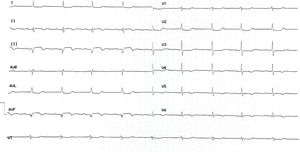We report the case of a 67-year-old woman, smoker and obese, who consulted for chest pain and syncope. Informed consent was obtained for the tests performed and publication of the case. Electrocardiography showed a very slow nodal rhythm with ST-segment elevation in the inferior wall (figure 1). Urgent coronary angiography depicted complete occlusion of the middle right coronary artery (figure 2A; ). Repeat thrombus aspiration failed to restore distal flow. A distal infusion catheter was advanced to verify the patency of the distal vessels (figure 2B, arrows indicate distal infusion orifices), and the first dose of local fibrinolytic agent (2000 IU of alteplase) was administered through this line. Further repeat thrombus aspiration did not succeed in opening the artery (figure 2C).
A decision was made to infuse a second dose of local fibrinolytic, with occlusion of the distal vessel. A guide extension catheter advanced to the middle segment was used to administer another 2000 IU dose of alteplase, while maintaining an inflated balloon before the cruz cordis during 5minutes (figure 2D,E). Following this maneuver, the vessel opened and TIMI 3 flow was restored in all branches, with grade 3 myocardial blush. The procedure was completed with stent implantation in the middle segment, with a good angiographic outcome (figure 2F; ) and recovery of sinus rhythm (figure 3). At discharge, the patient had normal systolic function.
Local fibrinolytic infusion with distal occlusion (known as the “marinade” technique) can be useful in cases of intraluminal thrombus refractory to aspiration and conventional local fibrinolysis.
FUNDINGNo funding was received for this study.
AUTHORS’ CONTRIBUTIONSAll the authors contributed to writing and revising the manuscript.
CONFLICTS OF INTERESTThere are no conflicts of interest in relation to this manuscript.
Supplementary data associated with this article can be found in the online version available at https://doi.org/10.1016/j.rec.2021.05.013






